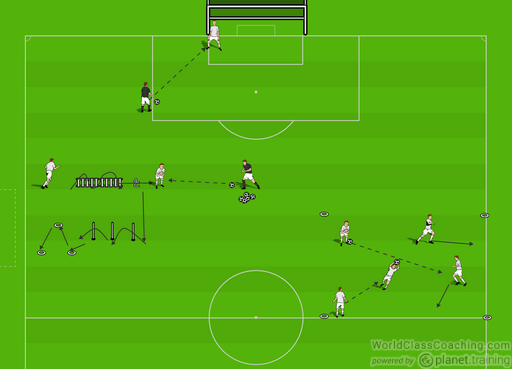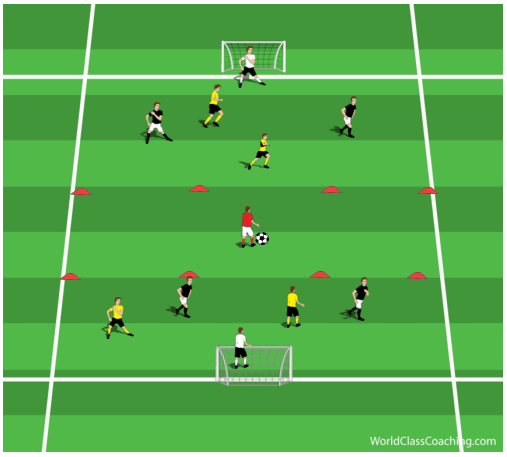- You are here:
- Home »
- shot stopping
Tag Archives for " shot stopping "

Tournament Goal Keeping
This is one of the articles and training sessions on goalkeeping and other topics that will be published this month in the Training Center. Click Here to learn how you can receive access to all of them.
By Josh Jones-Keen –
With summer here small sided tournaments are also here and with them they bring their own challenge for outfield players but also for those in goal.
The smaller and sometimes wider goals mean Keepers have to adjust their positioning more than if they were in a full size goal as shots are often hit at tight angles or cut back for a striker whose facing goal. Often the area is much smaller and Keepers might not be able to leave it, which brings its own problems! Distribution is also another challenge. Here is some prep that coaches and Keepers can work on for small tournaments.
Firstly read the rules! I was at a tournament the other day and there were a number of penalties for encroachment from a defender or for the Keeper leaving the box!
Shot Stopping
Most tournament goals are short and wide (not as wide as a full size but in comparison to the height they’re wide this means shots should be low and hard. Any shots higher should be a comfortable save for the Keeper getting across their goal with good footwork, quick short sidesteps. For diving saves:
Coaching Points
- Again good footwork is needed to get in to position
- Dive forwards to the ball, diving square or backwards could allow the ball to go for a corner or worse a goal if a mistake happens
- Body shape through the air and when landed should look like it would if catching a ball in to the chest area when standing
As well as dealing with shots a good way to practice footwork is with cone and ladder work. Once footwork is good you can add the shot stopping element to it.
Positioning
Like a regular game the Keeper should get down the line of the ball when the striker is preparing to shoot. The difficulty comes when with knowing how far to come off their line. This now depends on the size of the area.
Distribution
It’s important that the outfield work for the Keeper here. It’s tough if you’re looking at a field with no space and no movement. As a rule at least one defender should be free. Often there is a no kicking rule and sometimes a no over head throwing rule so we will look at rolling first.
Coaching Points
- Hold ball between palm and forearm with bent wrist
- Step forwards with the opposite foot, get low and bowl the ball along the floor
- Finger tips brush against the floor to ensure the ball doesn’t bobble/bounce
This can be practised one on one or if you have a group of Keepers I like to use it as a warm up in a 20 x 20 square. Coach shouts a type of distribution and the players perform the technique and move around the box. It’s also a great place to practice footwork.

By Josh Jones-Keen – Josh has been coaching Goalkeepers for over a decade & has both Outfield and Goalkeeper coaching awards from England and Scotland. He’s coached at a number of levels from grassroots to semipro and currently coaches non league Women’s team as well as a local academy.

Why is David De Gea so Good?
By Josh Jones-Keen –
David De Gea has just won Man United’s player of the year for the 3rd time in a row. This is a great achievement and one that might not be beaten for some time. Some will say this is indicative of how poor Man Utd are currently however let’s put this in perspective, whilst far from their recent best they are still chasing a champions league spot and have the chance to win the FA Cup for the first time in over 10 years. A lot of what has been good about Man Utd this season has come from the back so let’s look at what makes De Gea so good and how can try to emulate him.
Communication
When De Gea first started playing for United he looked a bit lost and out of sorts as did his back line even though it was one made up of great experience. Now whilst the defenders are not anywhere nearly as good as previous incumbents De Gea has got them listening to him and they are ready to be commanded. This drill will help start to get the Keeper talking. Effective communicating can add so much to a team.
Make sure when communicating orders are brief and to the point, direct and have clear ownership. For example how many times do you hear players ‘Back if you need/want’, I tell me Keepers to be positive and if they want the ball to demand it not suggest.
These instructions cover every drill a Keeper does including playing time come match day. Here are some to use and some to avoid:
- Keeper – When call this the Keeper is staking a claim to come and get that ball. Defenders know to get out the way and attackers know what’s coming. A keeper should be saying this when comfortable to let a shot come through to them and especially when claiming a cross.
- Mark (Avoid) also ‘Mark Up’, get your Keeper in to the habit of telling defenders who to mark ‘Jill number 10’
- 18yrds – Use this instead of the traditional ‘Step Up’ or ‘Get Out’ here players know exactly where to go
- Away – Tells players to just clear the ball. It’s not the best but equivalent of ‘if in doubt clear out’
Dealing with Crosses
Again when first coming to England De Gea had looked like he almost had never caught a crossed ball in his life, now he plucks them out of the air with ease.
Coaching Points
- Receiving high balls in the W formation
- Positioning, are they in a good place to get under the ball
- Footwork, are they moving around defenders to claim the ball
- Communication, ‘Away’ or ‘Keepers’
- Body Shape, is it correct when receiving the ball and is it ready to start a counter attack
Set Up
- 50Yrds by 35yrds
- 6 on 6 but 2v2 in each sq, to start with each player is restricted to their squares
- Attackers must get the ball wide to score from a cross
- Goal Keepers try to intercept and start counter attack

Shot Stopping
Shot stopping is what really brings De Gea the plaudits. Time and time again he will pull off a save that adds to United’s points total. They would be a lot worse off without him. If saves were celebrated like goals DDG would be an even more busy man.
Set Up
The field is 50 yards long, split in to 3 zones. One end zone is 18 yards deep while the other end zone is 25 yards deep. The different size end zone will encourage different types of shots.
Coaching Points
- On top of saving the ball in the correct way Keepers should look for
- Good positioning – before and after the shot
- Good body shape – before and after the shot
By Josh Jones-Keen – Josh has been coaching Goalkeepers for over a decade & has both Outfield and Goalkeeper coaching awards from England and Scotland. He’s coached at a number of levels from grassroots to semipro and currently coaches non league Women’s team as well as a local academy.
